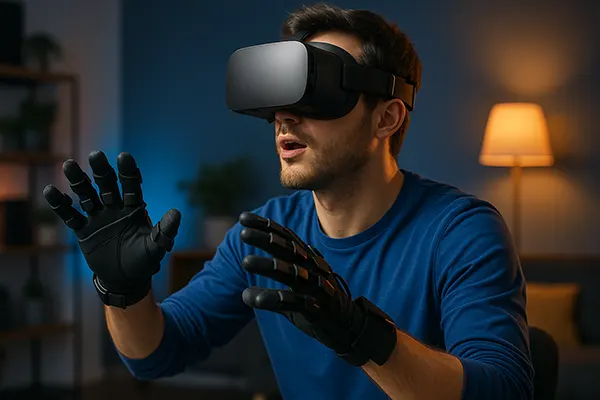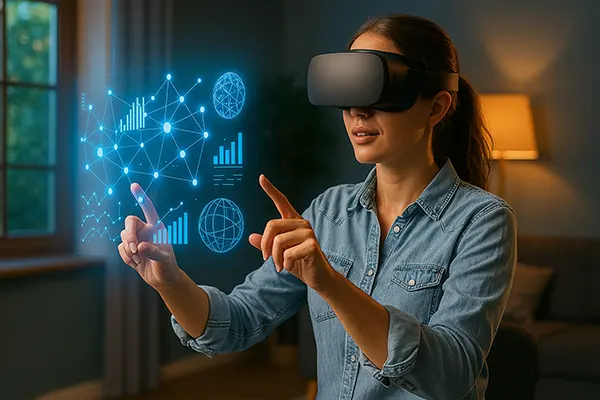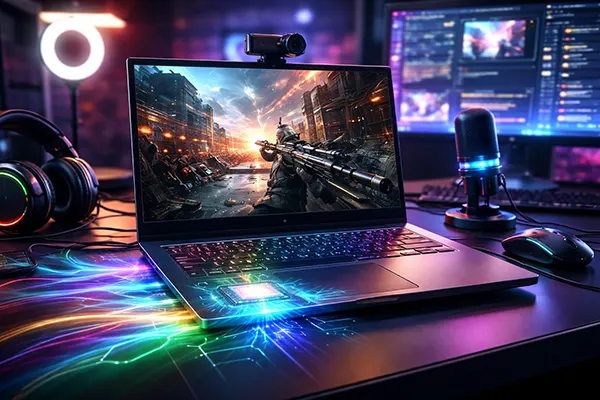
VR Haptic Gloves: Transforming the Way We Feel Virtual Worlds
In recent years, virtual reality has evolved far beyond visual immersion, moving into the realm of realistic tactile sensations. VR haptic gloves are at the forefront of this revolution, offering users the ability to physically feel virtual objects, textures, and even impacts. By simulating the sense of touch, these gloves open up new possibilities for gaming, training, and professional applications. In 2025, the technology has matured enough to deliver high-fidelity feedback while remaining compatible with major VR systems.
How VR Haptic Gloves Work
VR haptic gloves are designed with advanced sensors, actuators, and feedback systems that replicate the sensation of touch. They use precise pressure points, vibration motors, and in some cases, force feedback mechanisms to mimic different textures and forces. When a player picks up a virtual object, the gloves send signals that imitate the object’s weight, resistance, and surface texture. This makes the interaction feel more authentic, adding a deeper level of realism to the VR experience.
Modern haptic gloves integrate with motion tracking systems, using optical or inertial sensors to detect hand position and finger movement. This allows for seamless synchronisation between real and virtual hand gestures. Developers have also incorporated wireless connectivity, ensuring freedom of movement without restrictive cables. The use of lightweight materials ensures comfort during extended sessions, making them suitable for both casual gamers and professional VR users.
In addition to gaming, industries such as medical training, engineering, and remote robotics are adopting these gloves. For example, surgeons can practise delicate procedures with tactile accuracy, while engineers can manipulate virtual prototypes as if they were physical models. This versatility shows that haptic gloves are more than just a gaming accessory—they are a multi-industry innovation.
Current Market Leaders and Innovations
As of 2025, several companies dominate the VR haptic glove market. Firms like HaptX, Manus, and SenseGlove have developed models that push the limits of tactile realism. HaptX gloves, for example, use microfluidic actuators to create precise skin deformation, producing highly convincing touch sensations. Manus has focused on affordability and modularity, making their gloves adaptable for various VR setups. SenseGlove, meanwhile, has made strides in force-feedback technology, allowing users to feel resistance when grasping virtual objects.
Recent innovations include integration with AI-based sensory mapping, enabling gloves to adjust feedback dynamically depending on the user’s interaction. Some models now feature temperature simulation, adding a new layer of immersion by replicating warmth or coldness. Wireless charging and longer battery life have also become standard, reducing downtime between sessions.
Competition among manufacturers is driving rapid technological advancement, leading to lighter, more responsive, and more accurate gloves. This pace of innovation ensures that VR haptic technology will continue to evolve, potentially reaching mainstream consumer markets in the next few years.
Compatibility with VR Systems
Haptic gloves must integrate seamlessly with VR headsets and software to provide a complete immersive experience. Most modern gloves support compatibility with leading VR systems such as Meta Quest, HTC Vive, and Valve Index. This is achieved through dedicated SDKs (Software Development Kits) that allow developers to implement glove-specific features into their applications. Cross-platform support ensures that users can enjoy haptic feedback regardless of their preferred VR hardware.
For professional environments, haptic gloves often connect to simulation software used in training, design, and research. Integration with CAD systems, for example, enables engineers to manipulate 3D models with precision. In healthcare, gloves connect to surgical simulators, allowing trainees to practise techniques with realistic tactile responses. Educational institutions have also embraced these gloves for interactive learning in science and engineering courses.
However, full compatibility depends on regular software updates from both glove manufacturers and VR platform developers. In 2025, many leading companies have moved towards open-source compatibility frameworks, making integration smoother and reducing the time needed for developers to add haptic support to new VR experiences.
Challenges in System Integration
Despite significant progress, integrating haptic gloves with diverse VR systems still presents challenges. Latency is a key concern—if tactile feedback lags behind visual stimuli, the illusion of realism can be broken. Manufacturers are addressing this by improving data transmission speeds and optimising software drivers to reduce input delay. Wireless connectivity, while convenient, can sometimes introduce signal dropouts, which developers are working to minimise.
Another challenge lies in the calibration process. Gloves must be accurately mapped to each user’s hand size and finger length to ensure proper tracking. Modern systems now feature automatic calibration routines, but these can still require manual fine-tuning for best results. Additionally, ensuring consistent performance across various VR applications can be difficult, particularly when dealing with legacy software.
Nevertheless, ongoing collaboration between glove makers and VR developers is leading to more reliable and user-friendly integration. As these issues are resolved, haptic gloves are expected to become a standard peripheral for high-end VR setups, much like controllers and headsets are today.

Future Potential and Industry Impact
The future of VR haptic gloves goes far beyond gaming. In 2025, industries such as telemedicine, remote engineering, and defence training are actively exploring their applications. In telemedicine, doctors can use gloves to perform remote examinations or guide robotic instruments with a sense of touch. In remote engineering, specialists can manipulate hazardous materials or operate machinery in dangerous environments without physical presence.
In entertainment, haptic gloves could redefine how players interact with virtual worlds, offering more nuanced and responsive control than traditional VR controllers. Game developers are beginning to design mechanics specifically around tactile input, creating new genres of gameplay that rely on realistic touch interactions. This shift could lead to more immersive storytelling and interactive experiences.
From an economic perspective, as production scales and prices drop, VR haptic gloves could reach mass-market affordability. This would make them a common accessory in households, expanding the reach of VR beyond enthusiasts and professionals. As more people experience realistic touch in virtual environments, demand for advanced haptic feedback will only grow.
Predicted Technological Advancements
Looking ahead, researchers are working on even more sophisticated tactile feedback systems. Potential advancements include full-hand exoskeletons for greater force simulation, improved skin-stretch technology for directional touch sensations, and biometric sensors that adapt feedback to user reactions. Combining haptic gloves with other sensory devices, such as smell and taste simulators, could lead to fully multisensory virtual experiences.
Advances in AI could enable gloves to predict user movements and adjust feedback proactively, making virtual interactions feel even more natural. Furthermore, integration with cloud-based processing could reduce the hardware load on gloves, allowing for lighter and more comfortable designs. This would be particularly beneficial for extended VR sessions in professional training or competitive gaming.
Ultimately, VR haptic gloves are poised to become a cornerstone of next-generation virtual reality. As the technology matures and expands into new fields, the way we interact with digital environments may change forever, bringing virtual and physical realities closer together than ever before.


